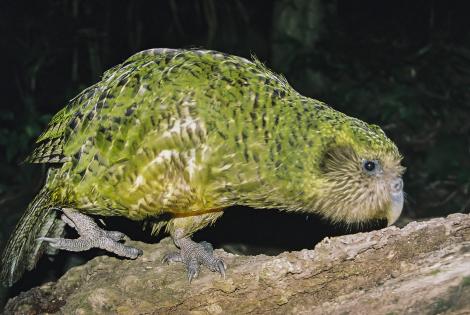Kakapo
Strigops habroptilus G.R. Gray, 1845
Other names: kākāpo, owl-parrot, tarapo, tarepo, night parrot
Geographical variation: Nil
The kakapo is a large, nocturnal,
flightless, lek-breeding parrot – a real oddity. It is also critically
endangered, and the focus of considerable conservation attention. Before
humans arrived it was common throughout New Zealand’s forests, but
predation by introduced mammals brought it to the brink of extinction - a
low point of about 50 birds only in the mid 1990s. The transfer of the
whole population to predator-free islands and intensive intervention in
every stage of its life has led to a steady increase in numbers.
Kakapo have no close relatives.
Identification
A large flightless forest-dwelling parrot, with a
pale owl-like face. Kakapo are moss green mottled with yellow and black
above, and similar but more yellow below. The bill is grey, and the legs
and feet grey with pale soles.
Voice: males make a deep booming call (“booming”)
and a loud wheezing call (“chinging”) to attract mates to their leks.
Both sexes make a loud high pitched skraak call (“skraaking”).
Similar species: kaka and kea are the only species
with which kakapo might be confused, but their moss green colour, large
size, flightlessness and nocturnal habits make them easy to distinguish.
It is also very unlikely that any kakapo exist other than at a few
managed sites, and so the chances of misidentification are very low.
Distribution and habitat
Once found throughout New Zealand, kakapo started
declining in range and abundance after the arrival of Maori. They
disappeared from the North Island by about 1930, but persisted longer in
the wetter parts of the South Island. The last birds died out in
Fiordland in the late 1980s. A population of less than two hundred birds
was discovered on Stewart Island in 1977, but this population was also
declining due to cat predation. During the 1980s and 1990s the entire
known population was transferred to Codfish Island off the coast of
Stewart Island, Maud Island in the Marlborough Sounds and Little Barrier
Island in the Hauraki Gulf. Since then birds have been moved between
Codfish, Maud and Little Barrier Islands as well as to and from newly
predator-free Chalky and Anchor Islands in Fiordland. Kakapo now occur
only on forested islands, though they previously appeared to have
inhabited a wide range of vegetation types.
Population
A total of 125 birds was known in September 2012.
All carry radio transmitters and are intensively monitored and managed.
It is possible there are a few birds remaining on Stewart Island, and
perhaps even a few in Fiordland.
Threats and conservation
Adult kakapo are vulnerable to predation by cats
and stoats, and their eggs and chicks can be killed by rats. Females
alone incubate eggs and raise chicks. As they must spend long periods
away from the nest feeding, eggs and chicks are particularly vulnerable
to predation when the nest is unattended. Chick-rearing is protracted,
and nests become smelly and easy for predators to find. Away from nests,
kakapo usually freeze and rely on cryptic colouration to hide them from
predators. While this strategy worked when the main predators were
birds that hunted by sight, it is a completely ineffective strategy to
avoid mammalian predators that hunt by smell.
Attempts to protect kakapo from introduced
predators by transferring them to Resolution Island in the 1890s failed
when stoats swam to the island. In the 1980s and 1990s transfers to
completely predator-free Maud Island and to Little Barrier and Codfish
Islands which only had kiore halted the kakapo’s decline. However, the
population did not start to increase until kiore were removed from the
islands and the birds were more intensively managed. Intensive
management comprised moving the birds between islands, protecting nests
from rats, supplementary feeding adults, closely monitoring eggs and
chicks, and rescuing and hand-raising any failing chicks.
Kakapo have very low genetic diversity and, as a
consequence, low fertility. Much recent conservation management has
focussed on managing matings, and using artificial insemination to
minimise further genetic loss.
Breeding
Kakapo breed in summer and autumn, but only in
years of good fruit abundance. On islands in southern New Zealand they
breed when the rimu trees fruit, which is once every 2 to 4 years.
Elsewhere in New Zealand they probably nested when southern beech
seeded, but the triggers for breeding in some northern places, including
Little Barrier Island, are unknown.
Kakapo are lek breeders. Males call from
track-and-bowl systems to attract females for mating. Males play no part
in incubation or chick-rearing. The nests are on or under the ground in
natural cavities or under dense vegetation. The 1-4 eggs laid in a
shallow depression in the soil or rotten wood, which is repeatedly
turned-over before and during incubation.
Behaviour and ecology
Kakapo are nocturnal and solitary, occupying the
same home range for many years. They forage on the ground and climb high
into trees. They often leap from trees and flap their wings, but at
best manage a controlled plummet.
Food
Kakapo are entirely vegetarian. Their diet
includes, leaves, buds, flowers, fern fronds, bark, roots, rhizomes,
bulbs, fruit and seeds. Diet varies seasonally.
Websites
Mission Kākāpō Copulation –
a light-hearted look at the extraordinary efforts that have been made
by the Department of Conservation's Kākāpō Recovery Team

No comments:
Post a Comment